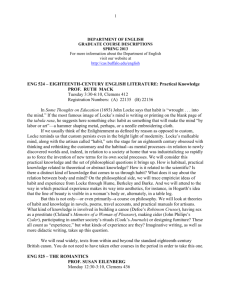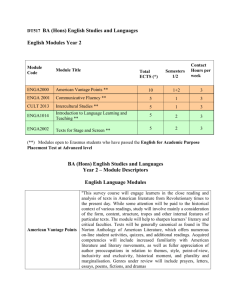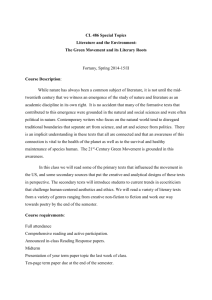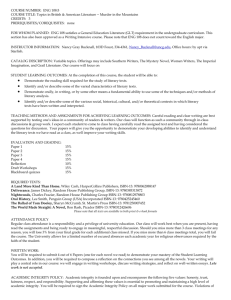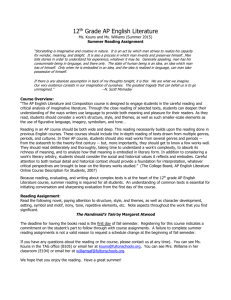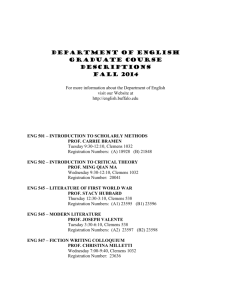Spring 2015 - University at Buffalo
advertisement
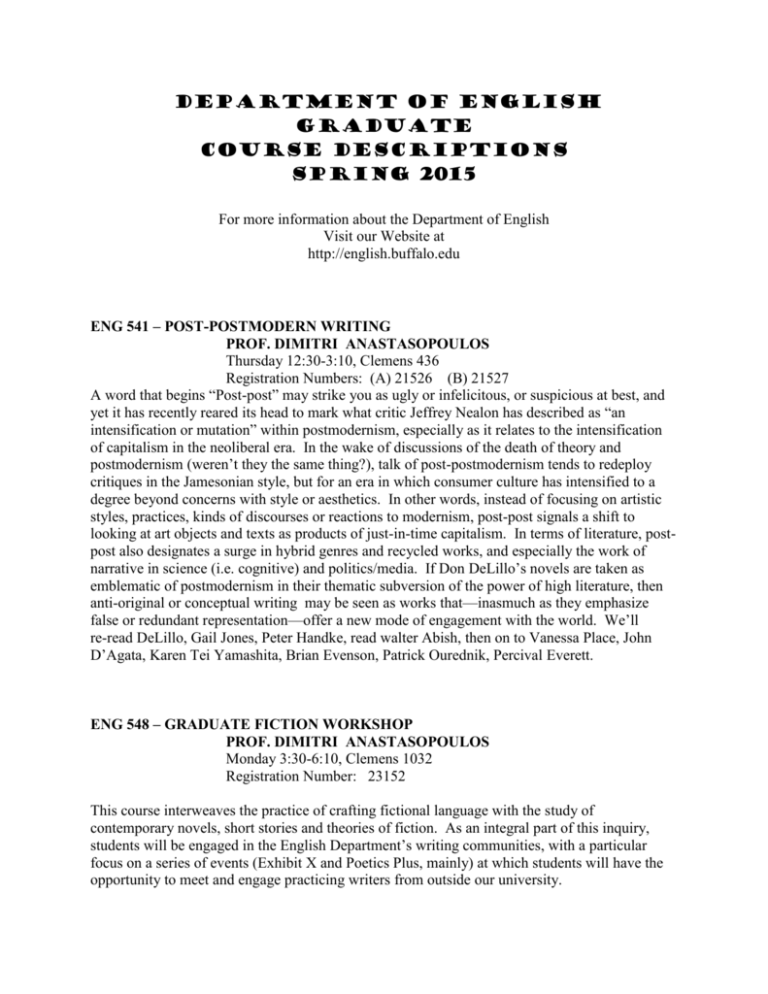
Department of english Graduate Course descriptions Spring 2015 For more information about the Department of English Visit our Website at http://english.buffalo.edu ENG 541 – POST-POSTMODERN WRITING PROF. DIMITRI ANASTASOPOULOS Thursday 12:30-3:10, Clemens 436 Registration Numbers: (A) 21526 (B) 21527 A word that begins “Post-post” may strike you as ugly or infelicitous, or suspicious at best, and yet it has recently reared its head to mark what critic Jeffrey Nealon has described as “an intensification or mutation” within postmodernism, especially as it relates to the intensification of capitalism in the neoliberal era. In the wake of discussions of the death of theory and postmodernism (weren’t they the same thing?), talk of post-postmodernism tends to redeploy critiques in the Jamesonian style, but for an era in which consumer culture has intensified to a degree beyond concerns with style or aesthetics. In other words, instead of focusing on artistic styles, practices, kinds of discourses or reactions to modernism, post-post signals a shift to looking at art objects and texts as products of just-in-time capitalism. In terms of literature, postpost also designates a surge in hybrid genres and recycled works, and especially the work of narrative in science (i.e. cognitive) and politics/media. If Don DeLillo’s novels are taken as emblematic of postmodernism in their thematic subversion of the power of high literature, then anti-original or conceptual writing may be seen as works that—inasmuch as they emphasize false or redundant representation—offer a new mode of engagement with the world. We’ll re-read DeLillo, Gail Jones, Peter Handke, read walter Abish, then on to Vanessa Place, John D’Agata, Karen Tei Yamashita, Brian Evenson, Patrick Ourednik, Percival Everett. ENG 548 – GRADUATE FICTION WORKSHOP PROF. DIMITRI ANASTASOPOULOS Monday 3:30-6:10, Clemens 1032 Registration Number: 23152 This course interweaves the practice of crafting fictional language with the study of contemporary novels, short stories and theories of fiction. As an integral part of this inquiry, students will be engaged in the English Department’s writing communities, with a particular focus on a series of events (Exhibit X and Poetics Plus, mainly) at which students will have the opportunity to meet and engage practicing writers from outside our university. A workshop represents a community of writers willing to take time and care with each other’s work-in-progress. This seems basic enough but it signals a level of commitment outside one’s writing and into multiple and challenging conceptions of writing offered by others. Our goal therefore is to offer acute, critical insights about the manuscripts we examine—their structure, plot (if they have plots), conceptual conceits, language, voice, character development and so on—keeping in mind the evolution of individual techne. ENG 550 – POETRY PROF. JUDITH GOLDMAN Tuesday 3:30-6:10, Clemens 538 Registration Number: 23153 During the first half of the semester, this seminar will be anchored in provocative essays from a multitude of disciplines, as well as readings in contemporary innovative poetry and poetics; we will use these common texts to come together on shared discursive ground for rambunctious discussion of ideas and poetic approaches and forms. Students will have plenty of opportunity to discuss and workshop their writing based on these readings and to circulate their independent work. The second half of the semester will be geared towards students developing thesis projects/manuscripts. This half of the course will be entirely student-centered and student-led, as students share project rationales, preliminary writing (past and present) related to these projects, sources, writing exercises and strategies for dealing with selected topics and materials, etc. In the course, students will be responsible for: 1st half: assigned readings, weekly critical and creative posts; 2nd half: assignments related to project development, with presentation of their own and others’ work; a final project prospectus that includes a project plan, a 5pp related poetics statement, and 15pp of preliminary writing. Note: because this class will be so collaboration-oriented and “real time”-sensitive, students will need to be punctual in posting whatever materials they are responsible for. We will make a clear, feasible schedule together at the beginning of the semester. ENG 563 – NATIVE AMERICAN AUTOBIOGRAPHY COL 000/APY 000 PROF. DENNIS TEDLOCK Wednesday 12:30-3:10, Clemens 540 Registration Numbers: (A) 21528 (B) 21529 The autobiographical narratives chosen for this seminar deal directly with issues of personal, linguistic, and ethnic identity. They describe and evoke cultural worlds that exist only in memory, but they also reach into the contemporary world, addressing historical, political, and legal issues. For post-colonial studies they are of prime importance, telling the story from the other side. Before 1920, native autobiographies followed the plot-line of progress, whether on the model of Christian salvation or that of social Darwinism. The publication of narratives that depart from this pattern began with the work of anthropologists of the American culturalhistorical school, who generally sided with Native Americans when it came to social, political, and religious issues. In contrast, British social anthropologists, who often worked in close association with colonial officials, took no interest in autobiographical narratives. In the genre sometimes called the “native life history,” the narrator, with or without the help of an interpreter, speaks to an ethnographer (or a person with ethnographic interests) who makes a transcription, whether on the spot or by working from a sound recording. The transcript then serves as the basis for a book that bears the name of the original narrator as its title, while the transcriber-editor is named as the author. At present, many ethnographers are themselves natives, and some of them take the role of writer while a native of an older generation takes the role of speaking narrator. Or the native narrator and the writer may be the same person, producing a work that takes the shape of an autobiographical novel. We will begin with Crashing Thunder, named for a Winnebago also known as Sam Blowsnake, whose narrative was published in both Winnebago and English translation by Paul Radin, the first ethnographer to publish a native life history. Alongside this work we will read ethnographer Nancy Oestreich Lurie’s Mountain Wolf Woman, Sister of Crashing Thunder. Next will come the most famous of Native American life histories, Black Elk Speaks, spoken by an Oglala Lakota holy man and written by poet-historian John J. Neihardt. We will use the critical edition published in 2008, which takes account of Neihardt’s departures from the transcript of the original interviews. Works by contemporary Native American writers will include Belle Herbert’s Shandaa: In My Lifetime (Athabaskan), N. Scott Momaday’s Way to Rainy Mountain (Kiowa), Leslie Marmon Silko’s Storyteller, Ray A. Young Bear’s Black Eagle Child: The Facepaint Narratives (Mesquakie), and Greg Sarris’ Mabel McKay: Weaving the Dream (Pomo). Also, we will view Sherman Alexie’s feature-length Smoke Signals. Weekly one-page response papers will be required, along with the classroom presentation of a research project based on autobiographies other than the assigned ones. Except for graduate students in English who take the course under the recitation rubric, a term paper will also be required. ENG 575 – PERFORMANCE AND RECEPTION IN FOUR KEYS PROF. DAMIEN KEANE Registration Numbers: (A1) 19577 (B1) 19578 PROF. HERSHINI YOUNG Registration Numbers: (A2) 23948 (B2) 23949 Tuesday 12:30-3:10, Clemens 1032 This course is a team-taught seminar: students must register for one section (the registration number corresponding to the “course” being offered by either professor), but under no circumstances should they register for both sections. As one seminar, both sections will meet on Tuesdays, 12:30–3:10. Approaching the reverberant and distorted histories of circum-Atlantic cultural production between the middle of the nineteenth century and the recent edges of the contemporary, this seminar will serve as both a methodological overview and a more focused survey. Through four units, or “keys,” the course will trace some of the political and aesthetic relations coalescing around practices of performance and reception, embodiment and retrieval, transmission and circulation. Each of these keys will be a necessarily mixed mode, grouping works as much for their disparities as for their continuities, their dissonances as for their correlations. Students will thus read critical material on black performance, as well as engage with visual, sonic and ludic performances that challenge conventional notions of body, history and literary criticism; they will also read literary works from within the Irish tradition of the bodily grotesque that confront the bureaucratization of the senses and the forms of knowing it sanctions. Over the course of the semester, we will repeatedly return to a central methodological relationship: how might a series of aesthetic works generate productive questions about historical interactions and political formations? In turn, how do performance and reception, in all their various registers, change the shape and texture of the literary? ENG 584 – TOWARDS A POETICS OF SUBTRACTION: Poetry and Poetics from the ‘70s to the Present PROF. STEPHEN McCAFFERY Wednesday 12:30-3:10, Clemens 438 Registration Numbers: (A) 23156 (B) 23157 This course will study the variant shifts in contemporary post-process poetics and their applications along a theoretical axis of subtraction; the latter term is employed in Alain Badiou’s sense as a quality different from negation.. From the poetics of Fluxus and intermedia we move to consider Language Poetry in its disjunctive manifestations, the procedural poetry of Oulipo and oulipean inspired theories, systematic-chance generation, through the recent inclinations to conceptual writing. The course will strive to maintain a balance between a consideration of theoretical issues and primary practical engagements. Writers and texts to be studied may include Dick Higgins, Edward Dorn “Gunslinger,” Susan Howe’s “The Liberties,” Geraldine Monk’s “Escafield Hangings,” Lyn Hejinian, Joan Retallack, Rachel Blau Du Plessis, Charles Bernstein, Jackson MacLow, Ron Silliman, Caroline Bergvall, Yedda Morrison, Christian Bök, and Kenneth Goldsmith. Substantial time will be spent in studying a trio of texts relating to the Holocaust: Reznikoff’s “Holocaust,” Robert Fitterman’s “Holocaust Museum,” and Heimrad Bäcker’s “transcript.” The majority of texts and poems will be available in a specially prepared Course Kit. Integral texts, however, may be required. ENG 609 – THE AMERICAN 1890s PROF. CARRIE BRAMEN Monday 3:30-6:10, Clemens 436 Registration Numbers: (A) 23160 (B) 23161 William James predicted that the year 1890 would be known as “the great epochal year in American literature.” With the publication of Principles of Psychology, his brother’s The Tragic Muse and Howells’s A Hazard of New Fortunes, James confidently saw the 1890s as a new era of American letters. That period, however, also marked a time of endings. The deaths of such figures as Herman Melville, Walt Whitman, Frederick Douglass and Harriet Beecher Stowe represented the passing of the Civil War generation, who witnessed the end of slavery and the acceleration of industry, the corporation and globalization. . This course will explore the literary, intellectual and cultural history of this transitional decade, a decade that saw the waning of Victorianism and the rise of Modernism. With the rise of Decadence, sexology, the New Woman and psychology, this period was one of innovation that challenged the conventions of time, place and memory. The fin-de-siecle also saw transformative inventions such as the automobile, moving pictures, and subway systems. But it also represents the continuing crisis of US imperialism, at home and abroad, with the Battle of Wounded Knee, the escalation of lynchings, the rise of segregation after Plessy v. Ferguson, and the Spanish American War of 1898, where the US acquired its first colonies including Cuba and the Philippines. It also marked a period of social movements from labor strikes (Pullman), the expansion of the suffragette movement, and anti-poverty protests (Coxey’s Army). We will explore an eclectic range of literary responses to this complicated and fascinating decade from the conventional rubrics of realism versus naturalism, the New Woman and local color (as a genre of literary access for writers of the margins) to pragmatism and psychological theories of “multiple selves” and “double consciousness.” ENG 613 – THE EIGHTEENTH-CENTURY NOVEL: THEORY AND PRACTICE PROF. RUTH MACK Friday 12:30-3:10, Clemens 1032 Registration Numbers: (A) 23265 (B) 23266 Introducing Joseph Andrews, Henry Fielding claims that his new genre, the “comic epic-poem in prose,” will bypass “precepts” for “examples.” In this course we will read texts, Fielding’s among them, that constitute examples of what we now call the novel as it emerged in Britain during the eighteenth century. We also will read theories of the novel, ranging from eighteenthcentury literary criticism by Joseph Addison and Samuel Johnson, to more modern critical histories of the novel by Ian Watt, Michael McKeon, and Nancy Armstrong. But such a line between practice and theory is not one the novel respects. We thus will be concerned additionally with what Fielding’s remark suggests: the novel’s tendency to theorize itself and to recast the relationship between theory and practice. And we will be concerned with how this novelistic tendency speaks to theory’s (our theory’s) own preferences for and rejections of theory or practice. Understanding the emergence of the novel in English is critical for studying the genre in later periods. How does a genre come into being? In studying these eighteenth-century texts we will be engaged in uncovering and reevaluating the dimensions of a very particular literary-historical moment. Yet from the outset our questions will necessarily reach beyond the eighteenth-century British context, because in staking its claims to newness the novel calls into question the very definition of “genre.” The consolidation of the novel’s identity puts on the table the most fundamental questions about the relationships between genre and culture, between history and theory, and between texts and readers. With this in mind, we will discuss how the novel’s beginnings can illuminate much later theories of subjectivity and fiction. Literary texts will include Eliza Haywood’s Love in Excess, Daniel Defoe’s Robinson Crusoe, Samuel Richardson’s Pamela, and Laurence Sterne’s Tristram Shandy. Theoretical material will include texts by Lukács, Bakhtin, Jameson, and Moretti. ENG 633 – MODERN POETRY: MARIANNE MOORE and MINA LOY PROF. CRISTANNE MILLER Thursday 3:30-6:10, Clemens 538 Registration Numbers: (A) 23162 (B) 23163 At the end of the 1910s, the two most talked about poets in New York were Marianne Moore and Mina Loy. Both were publishing their most innovative work between 1914 and 1925, both influentially affected the development of modernist form (especially in relation to the line as based more on abstract patterning or the visual than syntax), both had been reviewed very positively by the poets we now think of as canonical (Pound, Eliot, Williams), both were publishing in multiple little magazines, and Moore would go on to become one of the most important editors of the 1920s, editing The Dial from 1925-29 (she was also invited to take over editing Poetry at Harriet Monroe’s retirement but declined). This seminar will focus on the poetry written by these two women, primarily in the context of the New York scene, with special attention to gender issues and early twentieth-century feminism, the visual arts, little magazines, and the editorial problems faced by current readers and scholars of their poetry. Class participants will have some access to never-published and hard to access notebooks kept by Moore and used for the writing of her poetry, and perhaps an opportunity to engage in preliminary editing. ENG 653 – CRITICAL THEORY: On Vulnerability PROF. TIM DEAN Friday 3:30-6:10, Clemens 538 Registration Numbers: (A) 18312 (B) 18314 This interdisciplinary seminar will explore the problematic of vulnerability from a range of perspectives: feminist, psychoanalytic, philosophical, juridical, and cinematic. To aid in our approach to vulnerability, we will consider a constellation of related concepts—helplessness [Hilflosigkeit] and dependency; disability and debility; exposure and precarity; finitude; masochism. One of our guiding questions will be to assess to what extent human vulnerability is intrinsic (a consequence of human embodiment) and to what extent it is extrinsic (vulnerability produced through social and geopolitical processes). Through discourses of masochism, we also will consider what’s at stake in treating vulnerability as a source of pleasure as well as of pain. What sort of declarations of dependence make sense today? When reading vulnerability through the lens of Disability Studies, we will focus on cognitive as well as physical disabilities. This aspect of the seminar will serve as preparation for the Center for the Study of Psychoanalysis & Culture’s annual symposium (March 27, 2015), “Psychoanalysis and Neurocognitive Disability.” We will also be reading work by the British psychoanalyst Adam Phillips, in preparation for his weeklong visit to UB in late April 2015. Although not a film course per se, we will concretize our discussion of concepts via a number of recent films, including Michael Haneke, Amour (2012), Jeff Nichols, Take Shelter (2011), Barbara Bell and Anna Loretzon, Graphic Sexual Horror (2009), and others. Possible Readings Include: Jonathan Crary, 24/7: Late Capitalism and the Ends of Sleep (Verso, 2013) Freud, Inhibitions, Symptoms, and Anxiety (1926) Martha Fineman, “The Vulnerable Subject and the Responsive State” Eva Feder Kittay and Licia Carlson, eds., Cognitive Disability and Its Challenge to Moral Philosophy (Wiley Blackwell, 2010). [incl. essays by Michael Bérubé and Martha Nussbaum] Eva Kittay, Love’s Labor (Routledge, 1999) Adam Phillips and Barbara Taylor, On Kindness (Farrar, Straus & Giroux, 2009) Adam Phillips, “The Helpless” (in On Balance, 123-58). Judith Butler, Precarious Life [selections] K. Ziarek, “A Vulnerable World,” SubStance (2013) Jasbir Puar, “Prognosis Time: Towards a Geopolitics of Affect, Debility, and Capacity,” Women and Performance 19:9 (2009). Plus essays by D. W. Winnicott, Jean Laplanche, Bernard Stiegler, Martha Nussbaum, Janet Lyon, and others. ENG 686 – STUDY FIELD GENRE: SCIENCE FICTION PROF. NNEDI OKORAFOR Tuesday 12:30-3:10, Clemens 538 Registration Numbers: (A) 23720 (B) 23721 In this course, we will examine a sampling of speculative fiction novels and short stories (from science fiction to fantasy) in order to gain an appreciation and understanding of literature. Course objectives include: 1. 2. 3. 4. The defining critiquing of the genres. The uses of speculative fiction for entertainment, plot, and theme. Understanding the narrative devices of characterization, plot, and theme. Understanding critical standards and literary values. ENG 689 – BLAKE: ‘The Divine Body’: IMAGINATION, RELIGION, EROS & WAR PROF. DIANE CHRISTIAN Wednesday 3:30-6:10, Clemens 610 Registration Numbers: (A) 22289 (B) 22290 William Blake stood against the Enlightenment worship of Reason and cited Imagination as the superior faculty (“What is now proved was once, only imagined”). He analyzed reason as the accusatory moral faculty posed against the artistic/religious incorporative power of imagination (“If Morality was Christianity Socrates was the Saviour”). He interrogated and reshaped the Christian sense of the erotic (“Men are admitted into Heaven not because they have curbed or govern’d their Passions or have no Passions, but because they have Cultivated their Understandings”). He literally rewrote Milton in his epic Milton, bringing him back into time to correct his errors and reform his righteousness; his struggle with Milton was not a narcissistic ‘agony of influence’ but a testing of the truth of religious imagination. He understood imperialism and remarked that “Shakespeare & Milton were both curbed by the general malady & infection from the silly Greek & Latin slaves of the Sword.” Blake also anticipated radical insights of Feuerbach (“Thus men forgot that All deities reside in the human breast”), Marx (“The voice of slaves beneath the sun, and children bought with money”), Freud (Blake illustrated the Oedipus complex in The Book of Urizen”) and feminism (“Against the Patriarchal pomp and cruelty laboring incessant”). His is the most powerful analysis of religion, art, morality, war, emotion and gender in English poetry. To express it he created his own mythology which combined and thought with all the wisdom he knew—notably the Bible, artists and poets, and Plato, Bacon, newton, and Locke. This course will consider all his work, poetic and graphic, with emphasis on the body as the focusing structural metaphor. ENG 697 – DEFINITIONS OF AMERICA PROF. ROBERT DALY Wednesday 3:30-6:10, Clemens 436 Registration Numbers: (A1) 23164 (B1) 23165 In the autumn 2013 issue of New Literary History, Nancy Easterlin argues for adaptationist literary theory: “Everyday living is an interpretive process,” not just “textual,” but “a fundamental life process” that we “make special or elaborate in literary texts” and that “literary studies . . . increase the efficacy of meaning-making processes and the conscious awareness of humans” by “engaging in communal interpretation.” In the winter 2012 issue of New Literary History, Charles Altieri suggests that “seeing-in” to literature “affords the possibility of making more supple, more intricate, and more intense our repertories for engaging, understanding, and shaping experience in the world beyond the text.” And in Post-Postmodernism, or The Cultural Logic of Just-inTime Capitalism (Stanford: Stanford UP: 2012), Jeffrey Nealon argues for reading literature as a preparation for living in the larger world that includes but is not limited to language and literature. He argues that we have “relied on a kind of linguistic nostalgia, clinging to the life raft of the hermeneutics of suspicion,” and he suggests that we need to move from “the hermeneutics of suspicion” to a “hermeneutics of situation,” our own situations as well as those of the texts. These notions are all handy for the toolkit, and I see no need to throw out all the others just to make use of one. Still, with these priorities of our own time in mind, we shall read, within their reciprocal cultural contexts, several writings that help to define, create, or revise our communal cultures, both the discourse of nationalism and what Julia Kristeva calls the discourses of "nations without nationalism." We shall attend to their interactions with other cultures, with conversations among them, and with the ways in which they are both representative (participating in the cultural conversations of their times and ours) and hermeneutic (affording us practice and instruction in the arts of interpretation). Though its primary focus will be on the works themselves and the connections among them, this seminar will be informed by recent developments in our understanding of mirror neurons and cognitive theory but will not be dominated by them. Theories give us models for doing criticism, so it’s best to have several. For that reason, ecocriticism, feminism, trauma theory, post-analytic philosophy, virtue ethics, aesthetics, cultural theory, and any other theories we find useful will be welcome in our discussions of these texts but will not replace them. We shall also focus on agency and action, on what difference these thoughts make in our lives. As Hawthorne suggested long ago, “Thought has always its efficacy,” and as Amanda Anderson argued more recently [The Way We Argue Now. Princeton, Princeton UP, 2006], “We must keep in mind that the question, How should I live? is the most basic one; the response, As a knower, is simply one modification thereof.” We “must acknowledge the priority of normative questions and the fundamentally practical structure of human action and understanding.” In Jonathan Culler’s words, we shall explore the roles that literature “and narrative technique play” in rethinking “the conditions of possibility of the nation” [The Literary in Theory. Stanford: Stanford UP, 2007]. Still more recently, Claude S. Fischer has explored how “Americans handled the tension between individual liberty and society through an implicit covenant between member and group, which allowed free exit . . . but required commitment to the group” from those who stayed. We shall explore his notion that America moves “from a society of small, hierarchical circles . . . to a society of vastly more choices, where individuals are much more empowered and expected to build their own social bonds” in networks which all influence but none control [Made in America: A Social History of American Culture and Character. Chicago: U of Chicago P, 2010]. And in 2013 Bruno Latour, even while moving on from his earlier work on ANT (actant network theory), could still conclude An Inquiry into the Modes of Existence: An Anthropology of the Moderns (Cambridge, MA: Harvard UP, 2013) by suggesting that we, “abandoning the reassuring but vacuous help of a transcendent level,” now “shift attention . . . to NETWORKS” (caps and bold in original) and “look at the way the networks expand.” We shall not necessarily agree or disagree with all or any of these writers. We shall begin with the current understandings of the primary texts and see what we can to both learn and advance them. Each student will participate generously and cooperatively in seminar discussion and do one seminar report (15-20 minutes); each student taking the seminar intensively (for full credit) will also do one research essay on a topic of his or her own choosing. Texts: William Andrews, ed., Classic American Autobiographies (Mentor, Penguin) [contains Rowlandson, Franklin, Douglass, and Zitkala-Sa] Susanna Haswell Rowson, Charlotte Temple: A Tale of Truth, ed. Cathy N. Davidson (Oxford) Washington Irving, The Sketch Book of Geoffrey Crayon, Gent. (Signet) James Fenimore Cooper, The Pioneers (Harvard) Catharine Maria Sedgwick, Hope Leslie; or Early Times in the Massachusetts (Rutgers UP) Edgar Allan Poe, Selected Poetry and Tales (Broadview) Ralph Waldo Emerson, Emerson's Prose and Poetry, ed. Joel Porte and Saundra Morris (Norton Critical Edition) Margaret Fuller, Woman in the Nineteenth Century, ed. Larry J. Reynolds (Norton Critical Edition) Nathaniel Hawthorne, The Blithedale Romance (Bedford) Henry David Thoreau, Walden (Norton Critical Edition) Rebecca Harding Davis, Life in the Iron Mills (Bedford) Emily Dickinson, The Poems of Emily Dickinson: Reading Edition, ed. R. W. Franklin (Belknap, Harvard UP) Henry James, The Turn of the Screw and Other Short Novels (Signet) These texts, all paperbacks, will be available at the University bookstore. ENG 697 – DEFINITIONS OF AMERICA: ATTICA PROF. BRUCE JACKSON Monday 3:30-6:10, Clemens 610 Registration Numbers: (A2) 24105 (B2) 24106 This seminar is about the Attica prison revolt that started September 9, 1971, and ended four days later, on Mon day, September 13, 1971, in a wild fusillade of gunfire that left 9 hostages and 29 convicts dead, and many others wounded. That conclusion of the revolt was immediately followed by systematic torture of the surviving convicts. In the short term, there were felony indictments of some convicts and actual trials of a few of them (62 men were charged in 42 indictments with 1,289 separate felony counts). One of these trials resulted in a conviction, others resulted in guilty pleas in exchange for time served, or acquittals. The prosecutions stopped when the grand jury wanted to indict a State Trooper for homicide: the governor of New York shut the whole thing down. But that didn’t end it. There was an investigation commission, which issued a report. A portion of that report has been made public; New York’s attorney general last year moved to have the rest of it made public. He has been blocked from releasing it by, among others, attorneys for the New York State Police. There was a civil rights case filed by the convicts not long after the shootings and tortures. It didn’t come to trial until 1991; it wasn’t resolved until 2000. It was the longest-running, and perhaps one of the most muddled and bungled civil rights cases in U.S. legal history. But Attica wasn’t just a prison massacre or legal case. It was an iconic event in American culture. When Al Pacino’s character in Sidney Lumet’s Dog Day Afternoon (1975) stepped into the street, lifted his hand, and yelled, “Attica, Attica, Attica.” The film crowd in the street cheered; the audiences for the film needed no explanation for what was going on. There are several books about Attica, some of them good; some of them awful. There are also at least five films, some of them good; some of them awful. There is a huge amount of music connected to that convict revolt and that Monday slaughter: John Lennon’s “Attica State,” Tom Paxton’s “The Hostage,” Gill Scott-Heron’s “We Beg Your Pardon,” Paul Simon’s “Virgil,” Archie Shepp’s “Attica Blues,” Charles Mingus’s “Remember Rockefeller at Attica,” and more. The press played the fool in Attica: for a while, the two Buffalo daily papers (there were two then) and even the New York Times did stenography for prison officials. All, for example dutifully reported, on page one, that all nine dead hostages died because convicts had slit their throats. It wasn’t until the coroner’s report two days later that they had to backtrack and report that all dead hostages had been killed by police bullets. (That coroner eventually left the state: he got a ticket almost every time he went anywhere on the NY Thruway.) There is more: Attica was very much an event of its time. 1971 was a year of great political turmoil in the U.S. Young people outside were protesting the Vietnam War and engaging in the Civil Rights struggle. Most of the convicts in Attica were the same age as those people engaging in protest outside. Attica happened only 16 months after the killings at Kent State, not long after hundreds of police officers occupied and tear gassed the UB Campus, and only a few weeks after the death of George Jackson in the San Quentin yard. Attica was very much an event of its time; so was the way the media and the government dealt with it. In this seminar, which I hope will have participants from several departments, we’ll look at Attica as the cultural iconic event it was, as an event that set in motion a series of complex legal action s that continue to this day, and that occasioned several books and films of interest. We’ll look at artistic representations of that event, legal documentation and processes having to do with that event, and we’ll include in our discussion some of the few survivors of that event, including one of the attorneys in the first round of felony trials and one of the hostages.

